Channeling of Protons through Radial Deformed Double Wall Carbon Nanotubes
Abstract
1. Introduction
2. Theory
3. Results and Discussion
4. Conclusions
Author Contributions
Funding
Acknowledgments
Conflicts of Interest
Abbreviations
| DWNT | Double-wall carbon nanotubes |
| MC | Monte Carlo |
| MWNT | Multi-wall carbon nanotubes |
| SWNT | Single-wall carbon nanotubes |
References
- Iijima, S. Helical microtubules of graphitic carbon. Nature 1991, 354, 56–58. [Google Scholar] [CrossRef]
- Klimov, V.V.; Letokhov, V.S. Hard X-radiation emitted by a charged particle moving in a carbon nanotube. Phys. Lett. A 1996, 222, 424–428. [Google Scholar] [CrossRef]
- Dedkov, G.V. Fullerene nanotubes can be used when transporting gamma-quanta, neutrons, ion beams and radiation from relativistic particles. Nucl. Instrum. Meth. Phys. Res. B 1998, 143, 584–590. [Google Scholar] [CrossRef]
- Zhevago, N.K.; Glebov, V.I. Channeling of fast charged and neutral particles in nanotubes. Phys. Lett. A 1998, 250, 360–368. [Google Scholar] [CrossRef]
- Gevorgian, L.A.; Ispirian, K.A.; Ispirian, R.K. High energy particle channeling in nanotubes. Nucl. Instrum. Meth. Phys. Res. B 1998, 145, 155–159. [Google Scholar] [CrossRef]
- Biryukov, V.M.; Bellucci, S. Nanotube diameter optimal for channeling of high-energy particle beam. Phys. Lett. B 2002, 542, 111–115. [Google Scholar] [CrossRef]
- Greenenko, A.A.; Shulga, N.F. Fast ion passing through straight and bent nanotubes. Nucl. Instrum. Meth. Phys. Res. B 2003, 205, 767–772. [Google Scholar] [CrossRef]
- Krasheninnikov, A.V.; Nordlund, K. Multiwalled carbon nanotubes as apertures and conduits for energetic ions. Phys. Rev. B 2005, 71, 245408. [Google Scholar] [CrossRef]
- Bellucci, S.; Biryukov, V.M.; Cordelli, A. Channeling of high-energy particles in a multi-wall nanotube. Phys. Lett. B 2005, 608, 53–58. [Google Scholar] [CrossRef]
- Artru, X.; Fomin, S.P.; Shulga, N.F.; Ispirian, K.A.; Zhevago, N.K. Carbon nanotubes and fullerites in high-energy and X-ray physics. Phys. Rep. 2005, 412, 89–189. [Google Scholar] [CrossRef]
- Petrović, S.; Borka, D.; Nešković, N. Rainbows in transmission of high energy protons through carbon nanotubes. Eur. Phys. J. B 2005, 44, 41–45. [Google Scholar]
- Borka, D.; Petrović, S.; Nešković, N. Channeling star effect with bundles of carbon nanotubes. Phys. Lett. A 2006, 354, 457–461. [Google Scholar] [CrossRef]
- Borka, D.; Petrović, S.; Nešković, N.; Mowbray, D.J.; Mišković, Z.L. Influence of the dynamical image potential on the rainbows in ion channeling through short carbon nanotubes. Phys. Rev. A 2006, 73, 062902. [Google Scholar] [CrossRef]
- Borka, D.; Petrović, S.; Nešković, N.; Mowbray, D.J.; Mišković, Z.L. Influence of the dynamical polarization effect on the angular distributions of protons channeled in double-wall carbon nanotubes. Nucl. Instrum. Meth. Phys. Res. B 2007, 256, 131–136. [Google Scholar] [CrossRef]
- Matyukhin, S.I.; Frolenkov, K.Y. Critical Parameters of Channeling in Nanotubes. Tech. Phys. Lett. 2007, 33, 58–61. [Google Scholar] [CrossRef]
- Moura, C.S.; Amaral, L. Carbon nanotube ropes proposed as particle pipes. Carbon 2007, 45, 1802–1807. [Google Scholar] [CrossRef]
- Mišković, Z.L. Ion Channeling through Carbon Nanotubes. Radiat. Eff. Defect Solids 2007, 162, 185–205. [Google Scholar] [CrossRef]
- Borka, D.; Mowbray, D.J.; Mišković, Z.L.; Petrović, S.; Nešković, N. Dynamic polarization effects on the angular distributions of protons channeled through carbon nanotubes in dielectric media. Phys. Rev. A 2008, 77, 032903. [Google Scholar] [CrossRef]
- Zheng, L.-P.; Zhu, Z.-Y.; Li, Y.; Zhu, D.-Z.; Xia, H.-H. Ion mass dependence for low energy channeling in single-wall nanotubes. Nucl. Instrum. Meth. Phys. Res. B 2008, 266, 849–852. [Google Scholar] [CrossRef]
- Matyukhin, S.I. Efficiency of Ion Deviation by Bent Carbon Nanotubes. Tech. Phys. Lett. 2009, 35, 318–321. [Google Scholar] [CrossRef]
- Borka, D.; Mowbray, D.J.; Mišković, Z.L.; Petrović, S.; Nešković, N. Donut and dynamic polarization effects in proton channeling through carbon nanotubes. New J. Phys. 2010, 12, 043021. [Google Scholar] [CrossRef]
- Borka, D.; Petrović, S.; Nešković, N. Channeling of protons through carbon nanotubes. In Nanotechnology Science and Technology; Science Publishers: New York, NY, USA, 2011; pp. 1–78. ISBN 978-1-61122-050-6. [Google Scholar]
- Borka, D.; Lukić, V.; Timko, J.; Borka Jovanović, V. Using proton beams as a diagnostic tool in carbon nanotubes. Nucl. Instrum. Meth. Phys. Res. B 2012, 279, 169–172. [Google Scholar] [CrossRef]
- Borka, D.; Lukić, V.; Timko, J.; Borka Jovanović, V. Identification of the types of carbon nanotubes using donut effects. Nucl. Instrum. Meth. Phys. Res. B 2012, 279, 198–201. [Google Scholar] [CrossRef]
- Aleksandrov, V.A.; Filippov, G.M. Study of the rearrangement of a hydrogen atom moving parallel to the carbon nanotube wall. J. Surf. Investig. X-ray Synchrotron Neutron Tech. 2012, 6, 338–342. [Google Scholar] [CrossRef]
- Babaev, A.; Dabagov, S.B. Simulations of planar channeling of relativistic nuclei in a bent crystal. Eur. Phys. J. Plus 2012, 127, 62. [Google Scholar] [CrossRef]
- Zhang, Y.-Y.; Sun, J.-Z.; Song, Y.-H.; Mišković, Z.L.; Wang, Y.-N. Channeling of protons in single-walled carbon nanotubes based on kinetic and molecular-dynamics treatment. Carbon 2014, 71, 196–205. [Google Scholar] [CrossRef]
- Karabarbounis, A.; Sarros, S.; Trikalinos, C. Channeling of protons in various types of radially compressed carbon nanotubes. Nucl. Instrum. Meth. Phys. Res. B 2015, 355, 316–319. [Google Scholar] [CrossRef]
- Ćosić, M.; Petrović, S.; Nešković, N. Quantum primary rainbows in transmission of positrons through very short carbon nanotubes. Nucl. Instrum. Meth. Phys. Res. B 2016, 373, 52–62. [Google Scholar] [CrossRef]
- Zhu, Z.; Zhu, D.; Lu, R.; Xu, Z.; Zhang, W.; Xia, H. The experimental progress in studying of channeling of charged particles along nanostructure. In Proceedings SPIE, Proceedings of the International Conference on Charged and Neutral Particles Channeling Phenomena, Rome, Italy, 2004; SPIE: Bellingham, WA, USA, 2005; Volume 5974, pp. 1–13. [Google Scholar]
- Chai, G.; Heinrich, H.; Chow, L.; Schenkel, T. Electron transport through single carbon nanotubes. Appl. Phys. Lett. 2007, 91, 103101. [Google Scholar] [CrossRef]
- Hasegawa, M.; Nishidate, K. Radial deformation and stability of single-wall carbon nanotubes under hydrostatic pressure. Phys. Rev. B 2006, 74, 115401. [Google Scholar] [CrossRef]
- Imtani, A.N.; Jindal, V.K. Structure of armchair single-wall carbon nanotubes under hydrostatic pressure. Phys. Rev. B 2007, 76, 195447. [Google Scholar] [CrossRef]
- Shtogun, Y.V.; Woods, L.M. Electronic Structure Modulations of Radially Deformed Single Wall Carbon Nanotubes under Transverse External Electric Fields. J. Phys. Chem. C 2009, 113, 4792–4796. [Google Scholar] [CrossRef]
- Kan, B.; Ding, J.; Yuan, N.; Wang, J.; Chen, Z.; Chen, X. Transverse electric field–induced deformation of armchair single-walled carbon nanotube. Nanoscale Res. Lett. 2010, 5, 1144–1149. [Google Scholar] [CrossRef] [PubMed]
- Abu-Assy, M.K.; Soliman, M.S. Channeling potential in single-walled carbon nanotubes: The effect of radial deformation. Nucl. Instrum. Meth. Phys. Res. B 2016, 384, 93–99. [Google Scholar] [CrossRef]
- Borka Jovanović, V.; Borka, D.; Galijaš, S.M.D. Channeling of protons through radial deformed carbon nanotubes. Phys. Lett. A 2017, 381, 1687–1692. [Google Scholar] [CrossRef]
- Saito, R.; Dresselhaus, G.; Dresselhaus, M.S. Physical Properties of Carbon Nanotubes; Imperial College Press: London, UK, 2001. [Google Scholar]
- Gemmell, D.S. Channeling and related effects in the motion of charged particles through crystals. Rev. Mod. Phys. 1974, 46, 129–236. [Google Scholar] [CrossRef]
- Borka, D.; Petrović, S.; Nešković, N. Doughnuts with a <110> very thin Si crystal. J. Electron. Spectrosc. Relat. Phenom. 2013, 129, 183–187. [Google Scholar]
- Dang, Z.Y.; Motapothula, M.; Ow, Y.S.; Venkatesan, T.; Breese, M.B.H.; Rana, M.A.; Osman, A. Fabrication of large-area ultra-thin single crystal silicon membranes. Appl. Phys. Lett. 2011, 99, 223105. [Google Scholar] [CrossRef]
- Motapothula, M.; Dang, Z.Y.; Venkatesan, T.; Breese, M.B.H.; Rana, M.A.; Osman, A. Influence of the Narrow f111g Planes on Axial and Planar Ion Channeling. Phys. Rev. Lett. 2012, 108, 195502. [Google Scholar] [CrossRef]
- Motapothula, M.; Dang, Z.Y.; Venkatesan, T.; Breese, M.B.H.; Rana, M.A.; Osman, A. Axial ion channeling patterns from ultra-thin silicon membranes. Nucl. Instrum. Meth. Phys. Res. B 2012, 283, 29–34. [Google Scholar] [CrossRef]
- Karbunar, L.; Borka, D.; Radović, I. Image potential and stopping force in the interaction of fast ions with carbon nanotubes: The extended two-fluid hydrodynamic model. Nucl. Instrum. Meth. Phys. Res. B 2016, 366, 83–89. [Google Scholar] [CrossRef]
- Lindhard, J.K. Influence of crystal lattice on motion of energetic charged particles. In Matematisk-fysiske Meddelelserudgivet af Det Kongelige Danske Videnskabernes Selskab; Munksgaard: Copenhagen, Denmark, 1965; Volume 34. [Google Scholar]
- Molière, G. Theorie der Streuung schneller geladener Teilchen I: Einzelstreuung am abgeschirmten Coulomb-Feld. Zeitschrift für Naturforschung A 1947, 2, 133–145. [Google Scholar] [CrossRef]
- Stolterfoht, N. Simulation and analysis of ion guiding through a nanocapillary in insulating polymers. Phys. Rev. A 2013, 87, 012902. [Google Scholar] [CrossRef]
- Lemell, C.; Burgdorfer, J.; Aumayr, F. Interaction of charged particles with insulating capillary targets—The guiding effect. Prog. Surf. Sci. 2013, 88, 237–278. [Google Scholar] [CrossRef]
- Stolterfoht, N.; Yamazaki, Y. Guiding of charged particles through capillaries in insulating materials. Phys. Rep. 2016, 629, 1–107. [Google Scholar] [CrossRef]
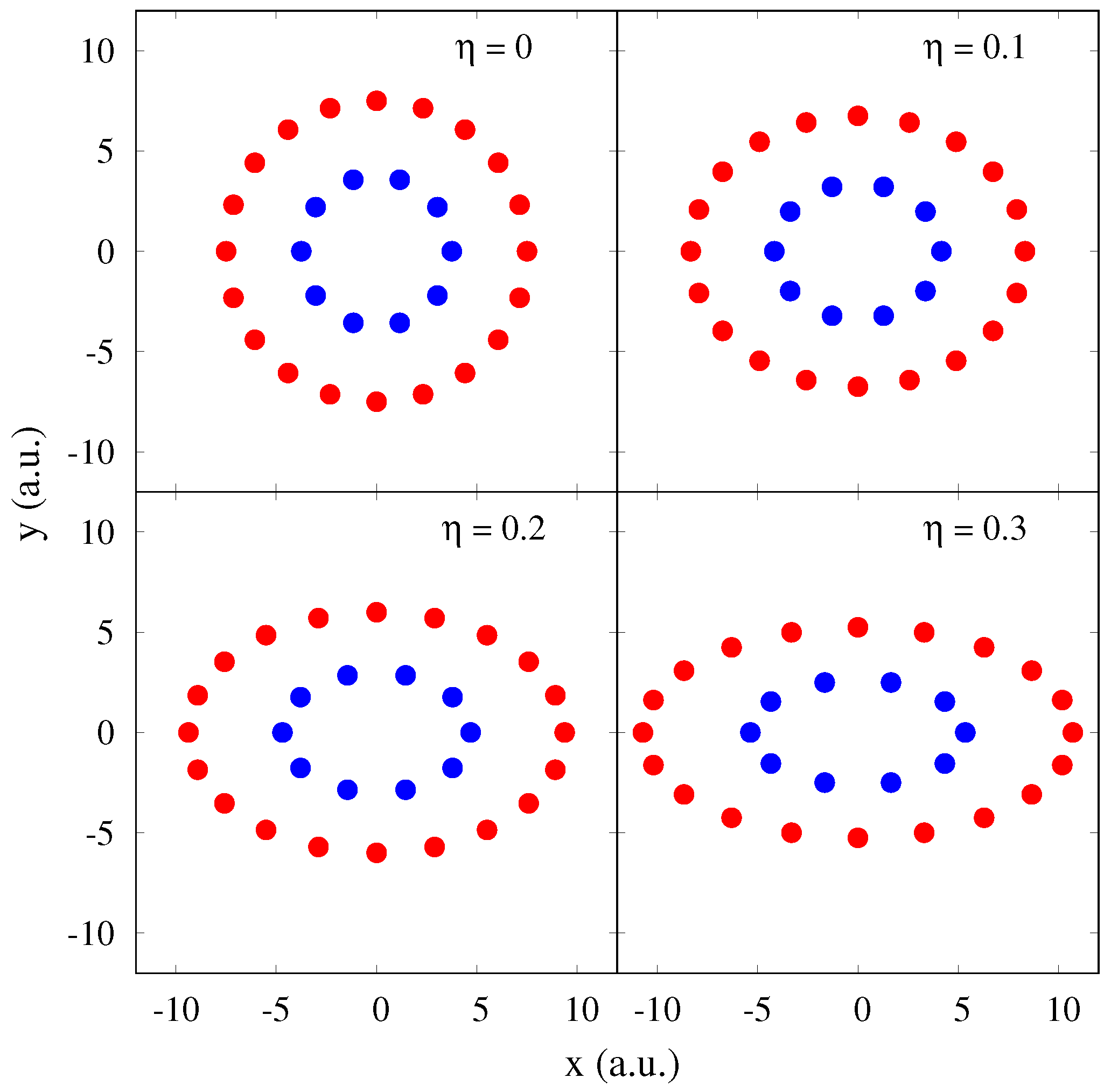
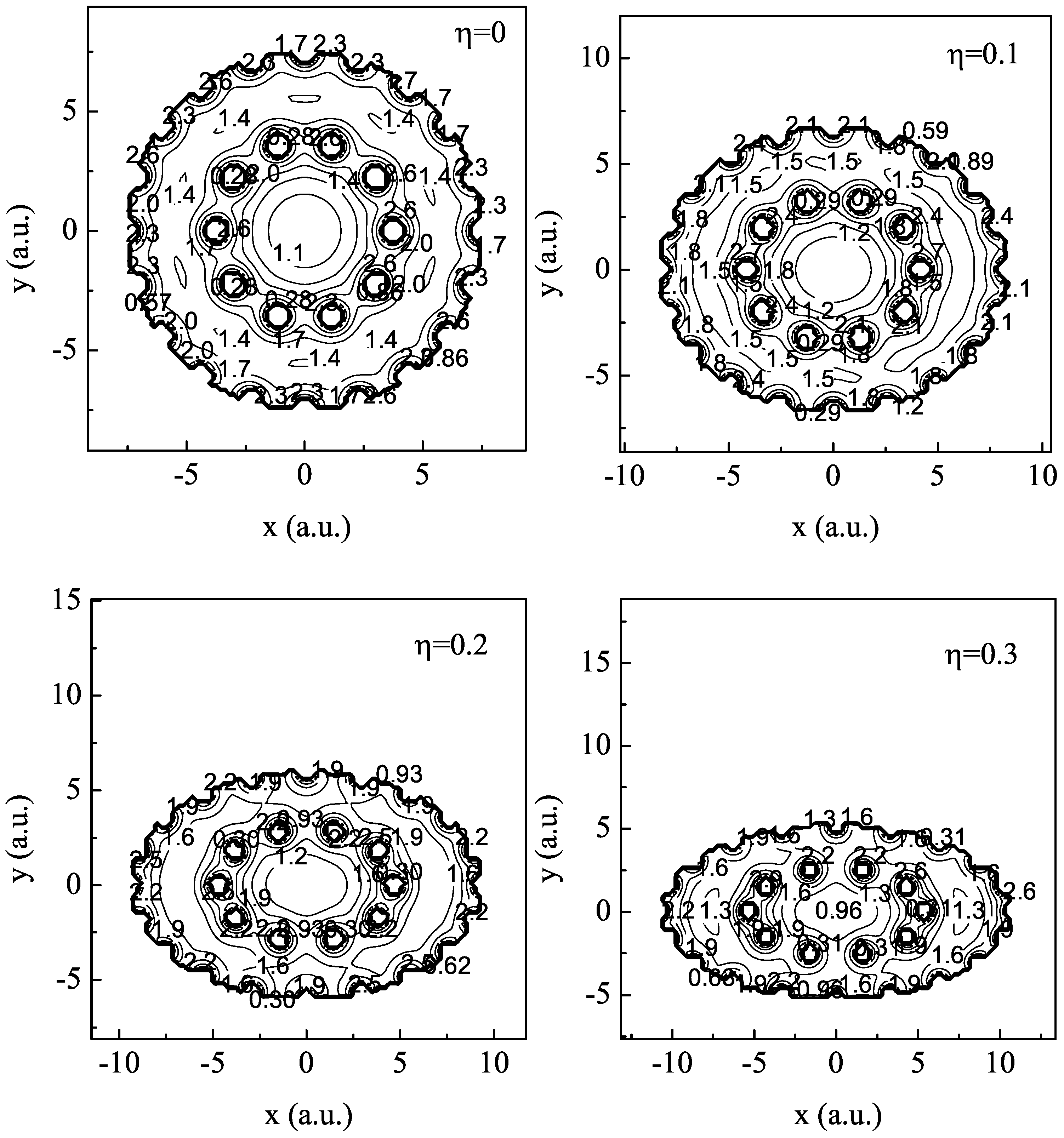
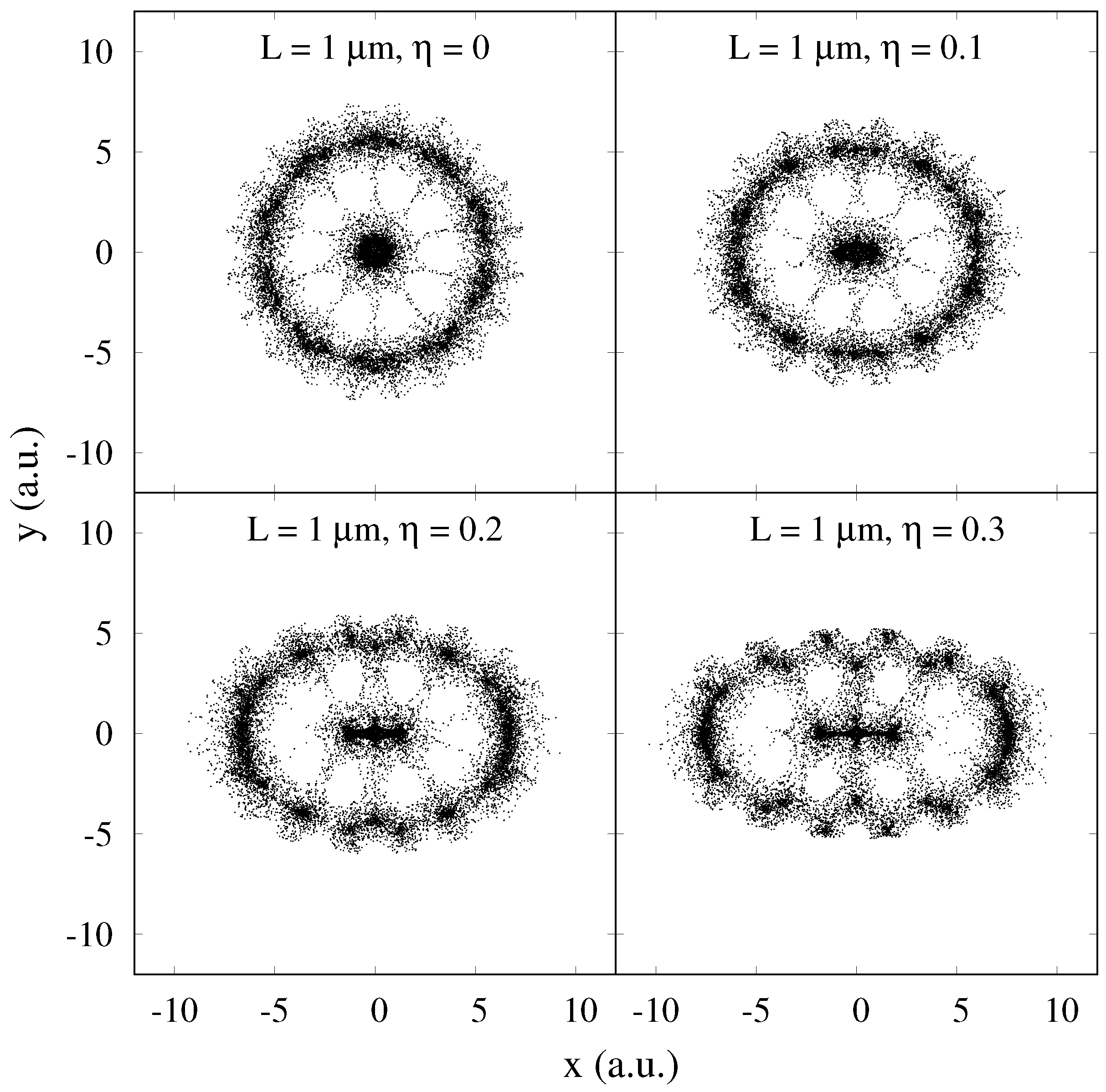
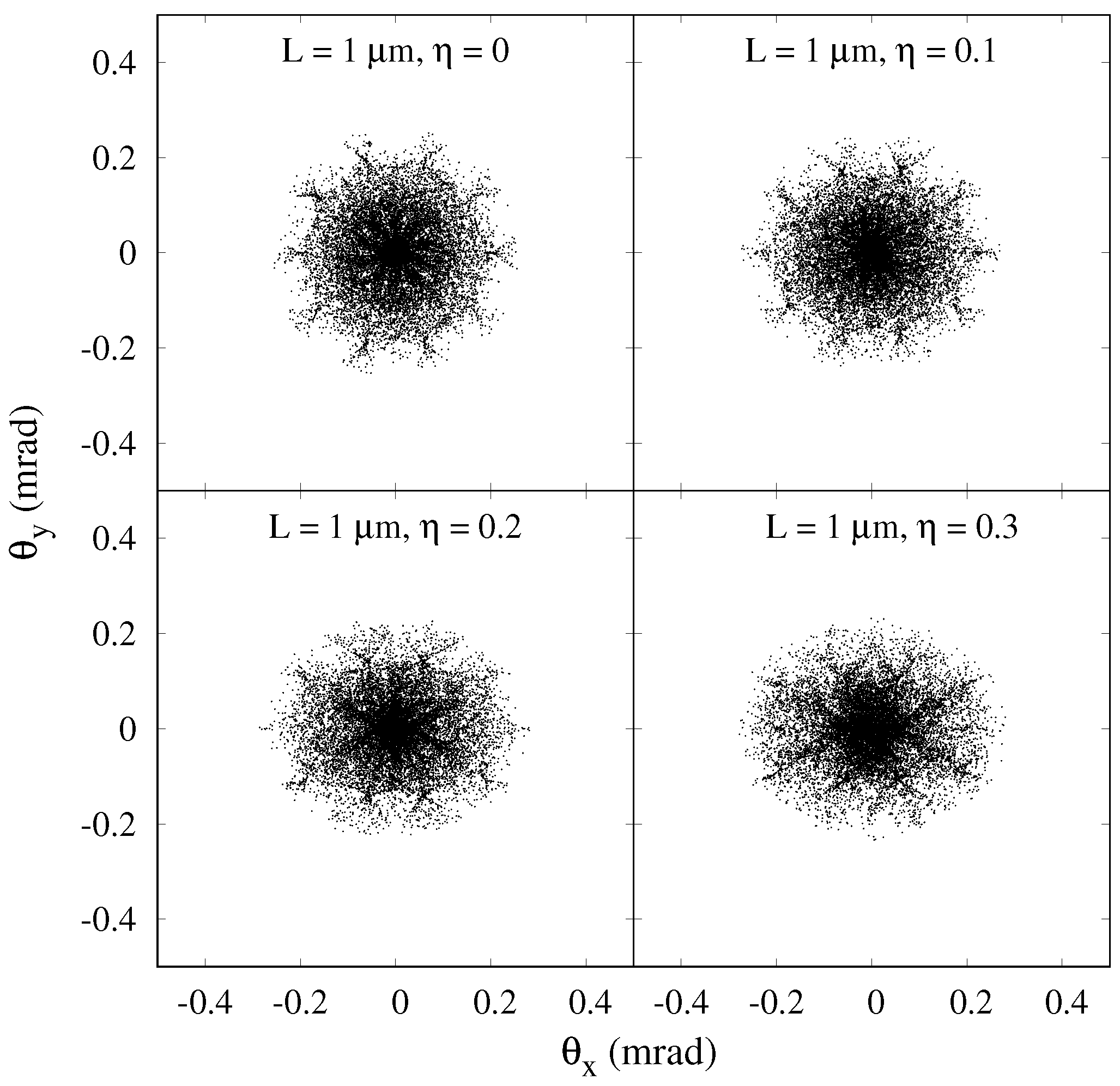
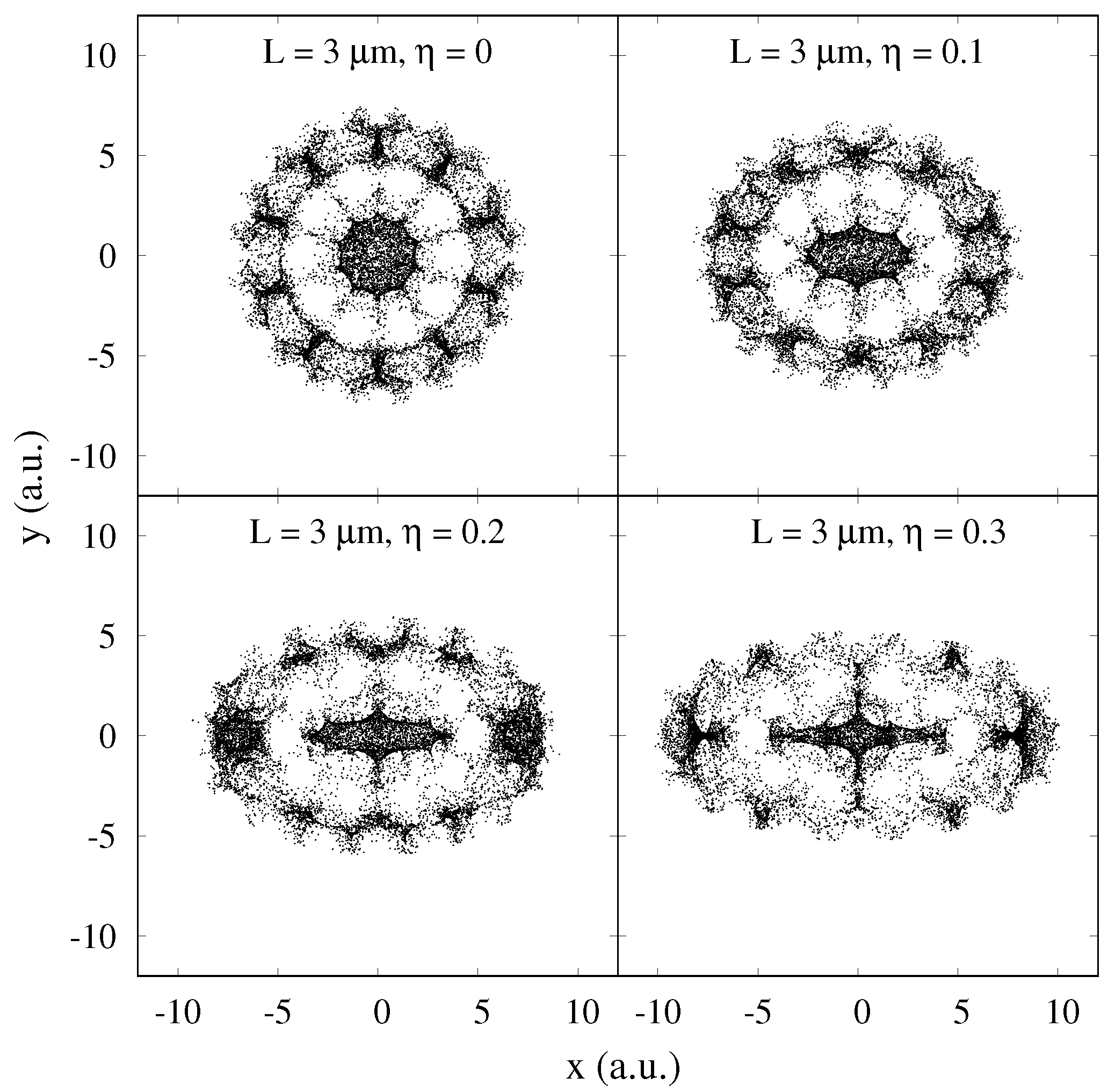

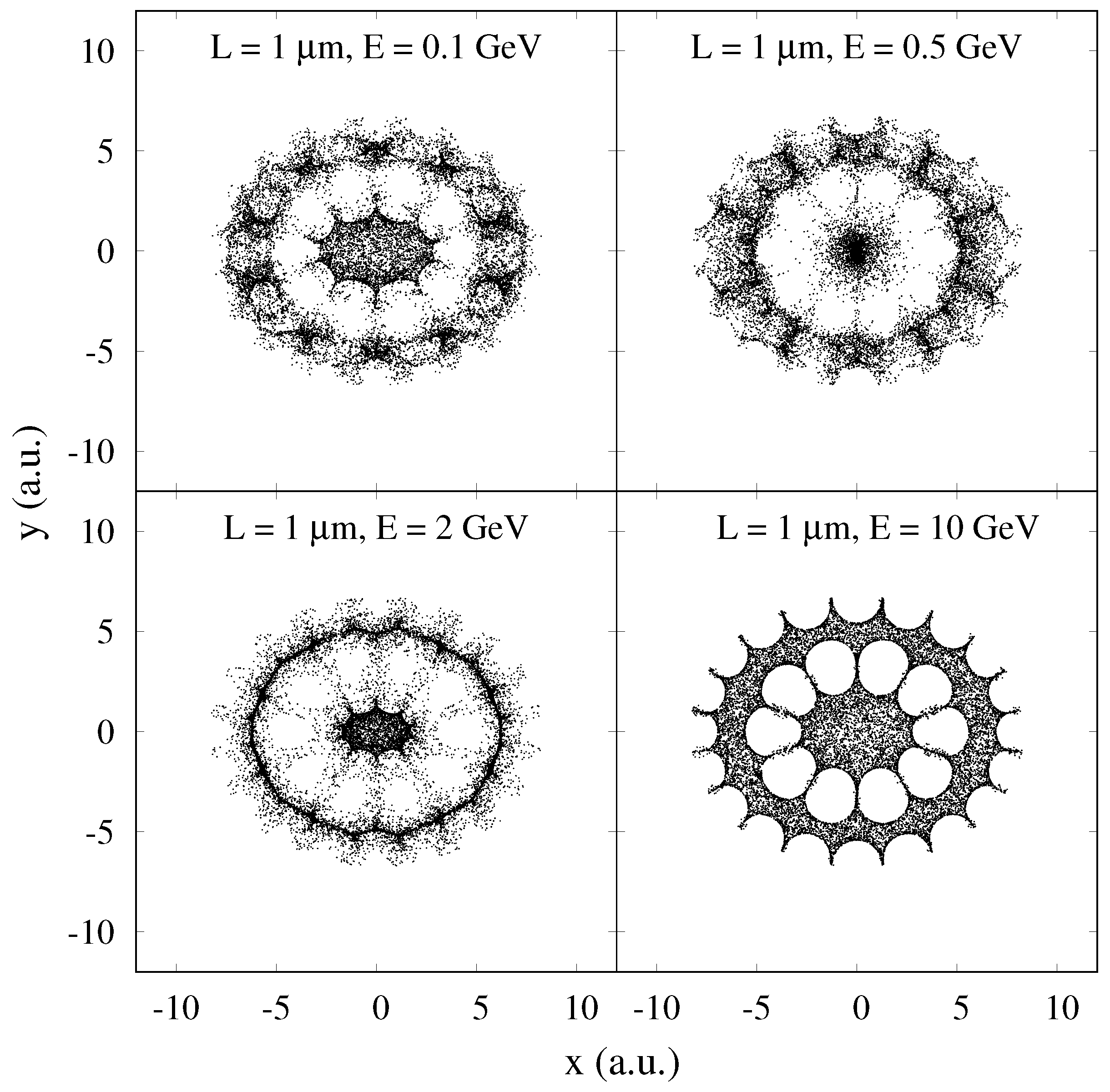
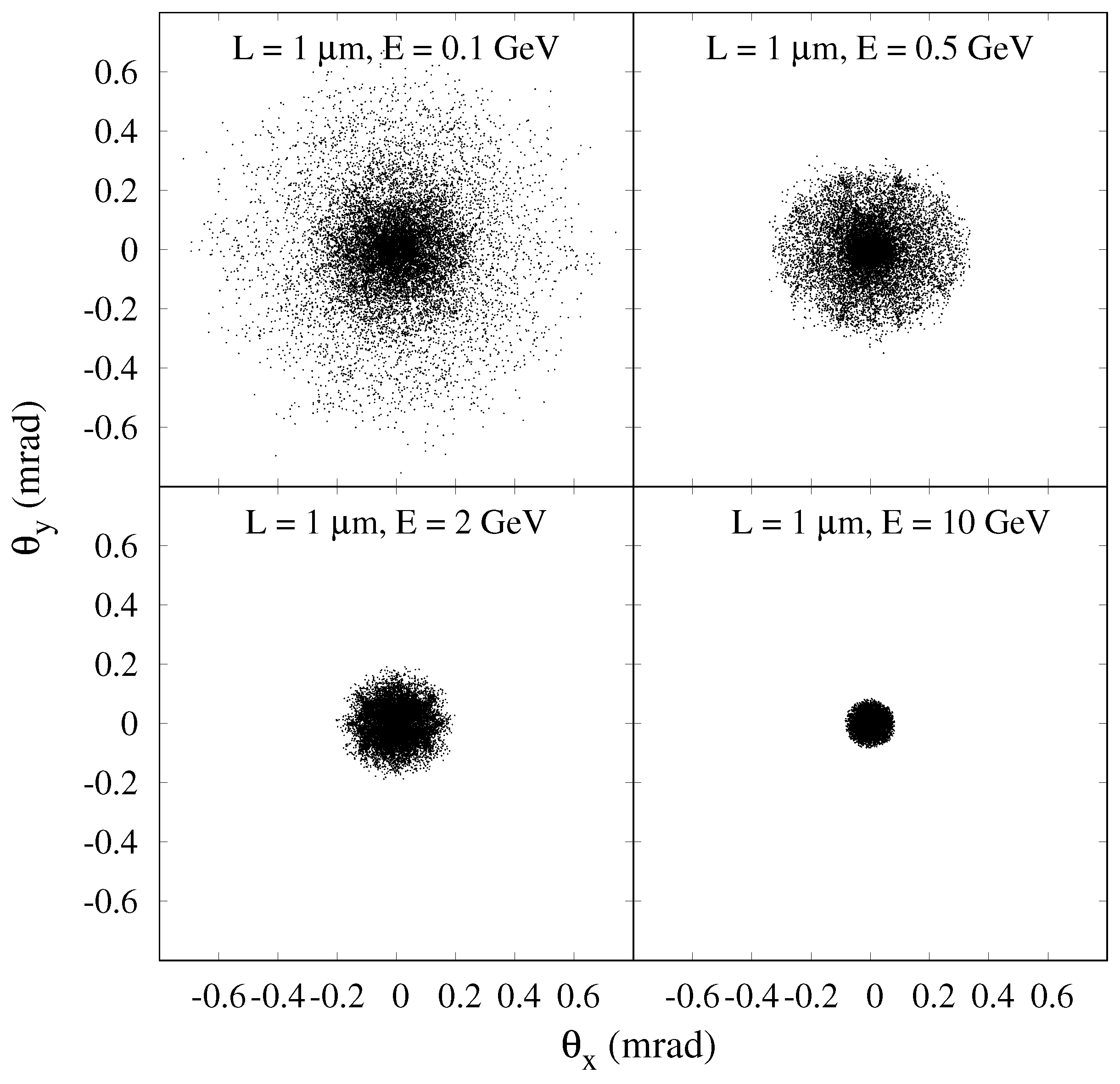
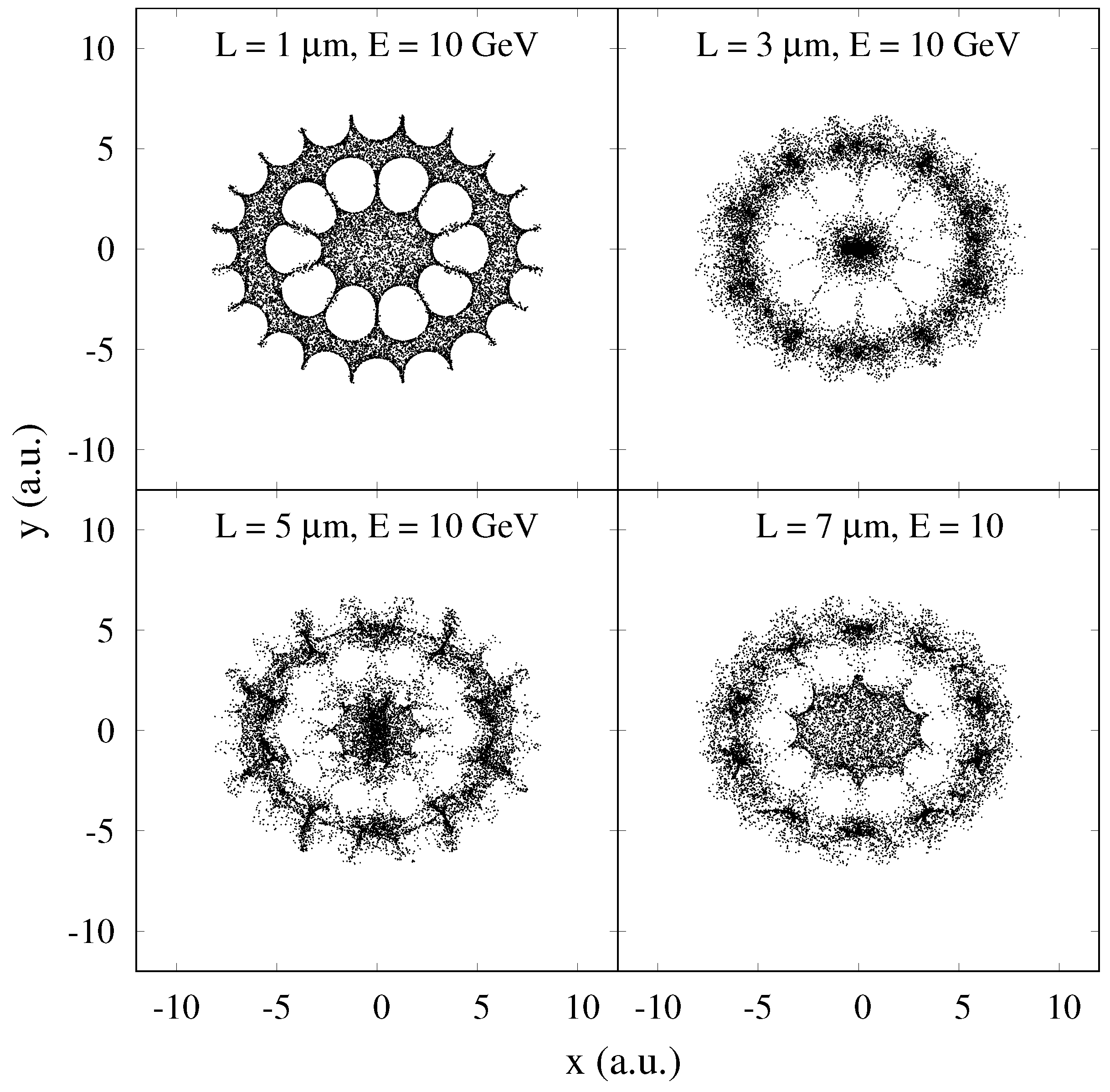

© 2019 by the authors. Licensee MDPI, Basel, Switzerland. This article is an open access article distributed under the terms and conditions of the Creative Commons Attribution (CC BY) license (http://creativecommons.org/licenses/by/4.0/).
Share and Cite
Borka, D.; Borka Jovanović, V. Channeling of Protons through Radial Deformed Double Wall Carbon Nanotubes. Atoms 2019, 7, 88. https://doi.org/10.3390/atoms7030088
Borka D, Borka Jovanović V. Channeling of Protons through Radial Deformed Double Wall Carbon Nanotubes. Atoms. 2019; 7(3):88. https://doi.org/10.3390/atoms7030088
Chicago/Turabian StyleBorka, Duško, and Vesna Borka Jovanović. 2019. "Channeling of Protons through Radial Deformed Double Wall Carbon Nanotubes" Atoms 7, no. 3: 88. https://doi.org/10.3390/atoms7030088
APA StyleBorka, D., & Borka Jovanović, V. (2019). Channeling of Protons through Radial Deformed Double Wall Carbon Nanotubes. Atoms, 7(3), 88. https://doi.org/10.3390/atoms7030088





